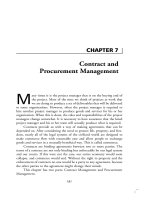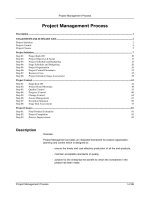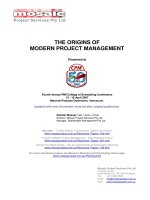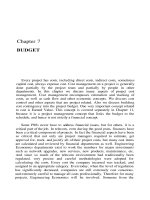Lecture Modern project management: Chapter 7 - Norman R. Howes
Bạn đang xem bản rút gọn của tài liệu. Xem và tải ngay bản đầy đủ của tài liệu tại đây (2.02 MB, 52 trang )
Chapter 8
Scheduling
Resources and
Costs
McGrawHill/Irwin
© 2008 The McGrawHill Companies, All Rights Reserved
8-2
The Resource Problem
Resources and Priorities
Project
network times are not a schedule until
resources have been assigned.
o The implicit assumption is that resources will be
available in the required amounts when needed.
o Adding new projects requires making realistic
judgments of resource availability and project durations.
Resource-Constrained Scheduling
Resource
leveling (or smoothing) involves
attempting to even out demands on resources by
using slack (delaying noncritical activities) to
manage resource utilization.
8-3
Types of Project Constraints
Technical or Logic Constraints
Constraints
related to the networked
sequence in which project activities must
occur
Resource Constraints
The
absence, shortage, or unique
interrelationship and interaction
characteristics of resources that require a
particular sequencing of project activities
8-4
Constraint Examples
FIGURE 8.2
8-5
Kinds of Resource Constraints
People
Materials
Equipment
Working Capital
8-6
Classification of a Scheduling Problem
Classification of Problem
Using
a priority matrix will help determine if the project
is time or resource constrained
Time Constrained Project
A
project that must be completed by an imposed date
o Time is fixed, resources are flexible: additional resources are
required to ensure project meets schedule.
Resource Constrained Project
A
project in which the level of resources available
cannot be exceeded
o Resources are fixed, time is flexible: inadequate resources will
delay the project.
8-7
A Third Constraint: Physical
8-8
Resource Allocation Methods
Limiting Assumptions
Splitting
activities is not allowed—once an
activity is start, it is carried to completion.
Level of resource used for an activity cannot
be changed.
Activities with the most slack pose the least
risk.
Reduction of flexibility does not increase risk.
The nature of an activity (easy, complex)
doesn’t increase risk.
8-9
Resource Allocation Methods (cont’d)
Time-Constrained Projects
Projects
that must be completed by an imposed
date
Require
the use of leveling techniques that focus
on balancing or smoothing resource demands by
using positive slack (delaying noncritical activities)
to manage resource utilization over the duration of
the project
o Peak resource demands are reduced.
o Resources over the life of the project are reduced.
o Fluctuation in resource demand is minimized.
8-10
Botanical Garden
FIGURE 8.3
8-11
Botanical Garden (cont’d)
FIGURE 8.3 (cont’d)
8-12
Resource Allocation Methods (cont’d)
Resource Demand Leveling Techniques for
Time-Constrained Projects
Advantages
o Peak resource demands are reduced.
o Resources over the life of the project are reduced.
o Fluctuation in resource demand is minimized.
Disadvantages
o Loss of flexibility that occurs from reducing slack
o Increases in the criticality of all activities
8-13
Resource Allocation Methods (cont’d)
Resource-Constrained
Projects
Projects
that involve resources that are limited in
quantity or by their availability
Scheduling
of activities requires the use of heuristics
(rules-of-thumb) that focus on:
1. Minimum slack
2. Smallest (least) duration
3. Lowest activity identification number
The
parallel method is used to apply heuristics.
o An iterative process that starts at the first time period of
the project and schedules period-by-period any activities
scheduled to start using the three priority rules
8-14
Resource-Constrained Schedule
through Period 2–3
FIGURE 8.4
8-15
Resource-Constrained Schedule
through Period 2–3
ES
ESresource
resourceload
loadchart
chart
FIGURE 8.4 (cont’d)
8-16
Resource-Constrained Schedule
through Period 2–3
Resource-constrained
Resource-constrainedschedule
schedulethrough
throughperiod
period2–3
2–3
FIGURE 8.4 (cont’d)
8-17
Resource-Constrained Schedule
through Period 5–6
Resource-constrained
Resource-constrainedschedule
schedulethrough
throughperiod
period5–6
5–6
FIGURE 8.5
8-18
Resource-Constrained Schedule
through Period 5–6
Final
Finalresource-constrained
resource-constrainedschedule
schedule
FIGURE 8.5 (cont’d)
8-19
Resource-Constrained Schedule
through Period 5–6
New,
New,resource-constrained
resource-constrainednetwork
network
FIGURE 8.5 (cont’d)
8-20
Computer Demonstration of
Resource-Constrained Scheduling
EMR Project
The
development of a handheld electronic
medical reference guide to be used by
emergency medical technicians and paramedics
Problem
There
are only eight design engineers who can
be assigned to the project due to a shortage of
design engineers and commitments to other
projects.
8-21
EMR
Project:
Network
View of
Schedule
before
Resource
s Leveled
FIGURE 8.6
8-22
EMR Project before Resources Added
FIGURE 8.7
8-23
EMR Project—Time Constrained Resource
Usage View, January 15–23, 2005
FIGURE 8.8A
8-24
Resource Loading Chart for EMR
Project,
January 15–23, 2005
FIGURE 8.A8B
8-25









